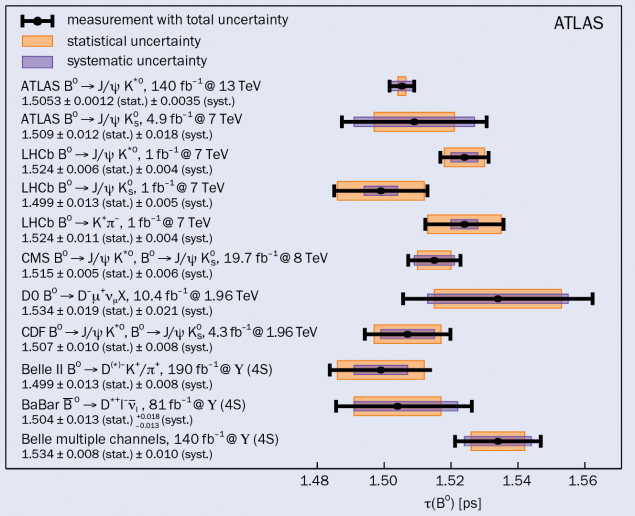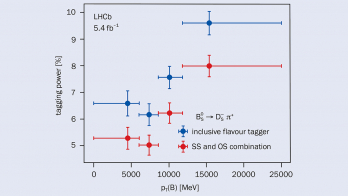A report from the ATLAS experiment.

As direct searches for physics beyond the Standard Model continue to push frontiers at the LHC, the b-hadron physics sector remains a crucial source of insight for testing established theoretical models.
The ATLAS collaboration recently published a new measurement of the B0 lifetime using B0 → J/ψK*0 decays from the entire Run-2 dataset it has recorded at 13 TeV. The result improves the precision of previous world-leading measurements by the CMS and LHCb collaborations by a factor of two.
Studies of b-hadron lifetimes probe our understanding of the weak interaction. The lifetimes of b-hadrons can be systematically computed within the heavy-quark expansion (HQE) framework, where b-hadron observables are expressed as a perturbative expansion in inverse powers of the b-quark mass.
ATLAS measures the “effective” B0 lifetime, which represents the average decay time incorporating effects from mixing and CP contributions, as τ(B0) = 1.5053 ± 0.0012 (stat.) ± 0.0035 (syst.) ps. The result is consistent with previous measurements published by ATLAS and other experiments, as summarised in figure 1. It also aligns with theoretical predictions from HQE and lattice QCD, as well as with the experimental world average.
The analysis benefitted from the large Run-2 dataset and a refined trigger selection, enabling the collection of an extensive sample of 2.5 million B0 → J/ψK*0 decays. Events with a J/ψ meson decaying into two muons with sufficient transverse momentum are cleanly identified in the ATLAS Muon Spectrometer by the first-level hardware trigger. In the next-level software trigger, exploiting the full detector information, these muons are then combined with two tracks measured by the Inner Detector, ensuring they originate from the same vertex.
The B0-meson lifetime is determined through a two-dimensional unbinned maximum-likelihood fit, utilising the measured B0-candidate mass and decay time, and accounting for both signal and background components. The limited hadronic particle-identification capability of ATLAS requires careful modelling of the significant backgrounds from other processes that produce J/ψ mesons. The sensitivity of the fit is increased by estimating the uncertainty of the decay-time measurement provided by the ATLAS tracking and vertexing algorithms on a per-candidate basis. The resulting lifetime measurement is limited by systematic uncertainties, with the largest contributions arising from the correlation between B0 mass and lifetime, and ambiguities in modelling the mass distribution.
ATLAS combined its measurement with the average decay width (Γs) of the light and heavy Bs-meson mass eigenstates, also measured by ATLAS, to determine the ratio of decay widths as Γd/Γs = 0.9905 ± 0.0022 (stat.) ± 0.0036 (syst.) ± 0.0057 (ext.). The result is consistent with unity and provides a stringent test of QCD predictions, which also support a value near unity.
Further reading
ATLAS Collab. 2024 arXiv:2411.09962.
ATLAS Collab. 2021 Eur. Phys. J. C 81 342.








